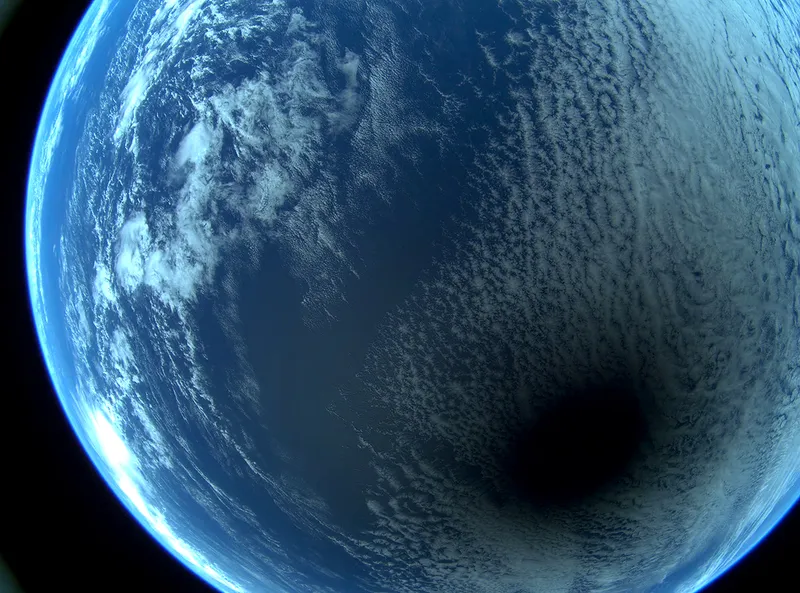While most eyes were on the Sun during the April 8 2024 total solar eclipse, scientists were using the event to discover how Earth’s atmosphere behaves when the Sun is blocked.
One such mission was NASA's APEP (Atmospheric Perturbations Around the Eclipse Path) mission, part of a USA-wide science initiative to examine how a total solar eclipse affects Earth's atmosphere.
Robert Clayton is a research scientist at Embry-Riddle Aeronautical University, Florida, who studies phenomena in Earth’s atmospheric plasma.
He was part of the APEP team, and we got the chance to catch up with him to find out what it involved, and what he and the team are hoping to discover.

What happens to Earth’s atmosphere during a solar eclipse?
During an eclipse, the Sun is obscured by the Moon as it passes in front of Earth.
The Sun is a source of a lot of Earth’s energy. When the Moon obscures that, it’s like shutting off Earth’s power.
That causes a variety of effects.
The atmosphere gets a lot colder, which could change the wind patterns; if you’re standing under the solar eclipse, you can feel this drop in temperature.
There are also changes in condensation and precipitation, like when you start up a cold car and suddenly get condensation all over the windows.
You cause a bunch of turbulence, ending up with a very cold region that travels across Earth, surrounded by hot regions where the Sun is still warming up the rest of the atmosphere.
We’re trying to study that atmospheric irregularity, particularly to look at how it stirs up the neutral particles and charged particles – or plasma – in the ionosphere.

What is Earth’s ionosphere?
It’s part of our atmosphere. We’re studying an altitude range between 70km and 150km (43–93 miles) above Earth’s surface.
This region has both plasma and neutral particles.
If you go much higher, almost everything is charged or ‘ionised’ and there are not a lot of neutral gases.
Go much lower than the ionosphere and you run into the opposite problem: almost everything is neutral, like the air we breathe.

What changes are you hoping to detect in the ionosphere?
We’re trying to look at the density of the plasma there. In theory, when the Sun’s energy is removed, the number of charged particles should fall.
This creates a gap under the eclipse with fewer charged particles.
Particles outside this gap then try to flow in to fill the void.
As the particles flow in, this creates the turbulence that we’re trying to measure.
This will tell us about the behaviour of the ionosphere’s plasma.
Computational modelling is a big part of what we do, other than the measurements themselves. By assimilating all this information, we can build a picture of what’s going on.
Your work is part of NASA’s APEP mission. What is that?
APEP (Atmospheric Perturbations Around the Eclipse Path) is part of a nationwide science campaign in the US to understand the atmosphere during the eclipse.
It targets plasma density and temperature, and works in conjunction with other measurements, like ground-based observations and satellite studies.
We launched a series of three rockets: one before the eclipse, to study the initial state of the atmosphere; one during the eclipse, to study its direct effects; and one after, to study the system as it recovers back to its normal state.

What are the rockets and instruments like?
We used sounding rockets. A full flight is a little over 10 minutes, and the timing is crucial.
You want to make sure the rocket is launched in time to see each stage of the eclipse.
Most of the instruments we built are called Langmuir probes.
When you take an exposed piece of metal and put it inside a plasma, like in the ionosphere, it will collect charged particles because metal is a conductor.
The more plasma, the more charged particles are collected.
So, we use these probes to tell us about the density of the plasma in the ionosphere. We also measure the magnetic field strength with magnetometers, and atmospheric drag with accelerometers.
What’s next for your team?
We have a lot of data processing to do. There were 14 instruments per rocket, so that’s 42 in total.
We have to go through and ensure that we interpret all that information correctly and combine that with NASA data, so we know what direction the rockets were facing at any given time.
We have another mission called SEED that uses a similar set of instruments; it will launch next year and we’re also simultaneously building the hardware for that.
This interview appeared in the June 2024 issue of BBC Sky at Night Magazine

